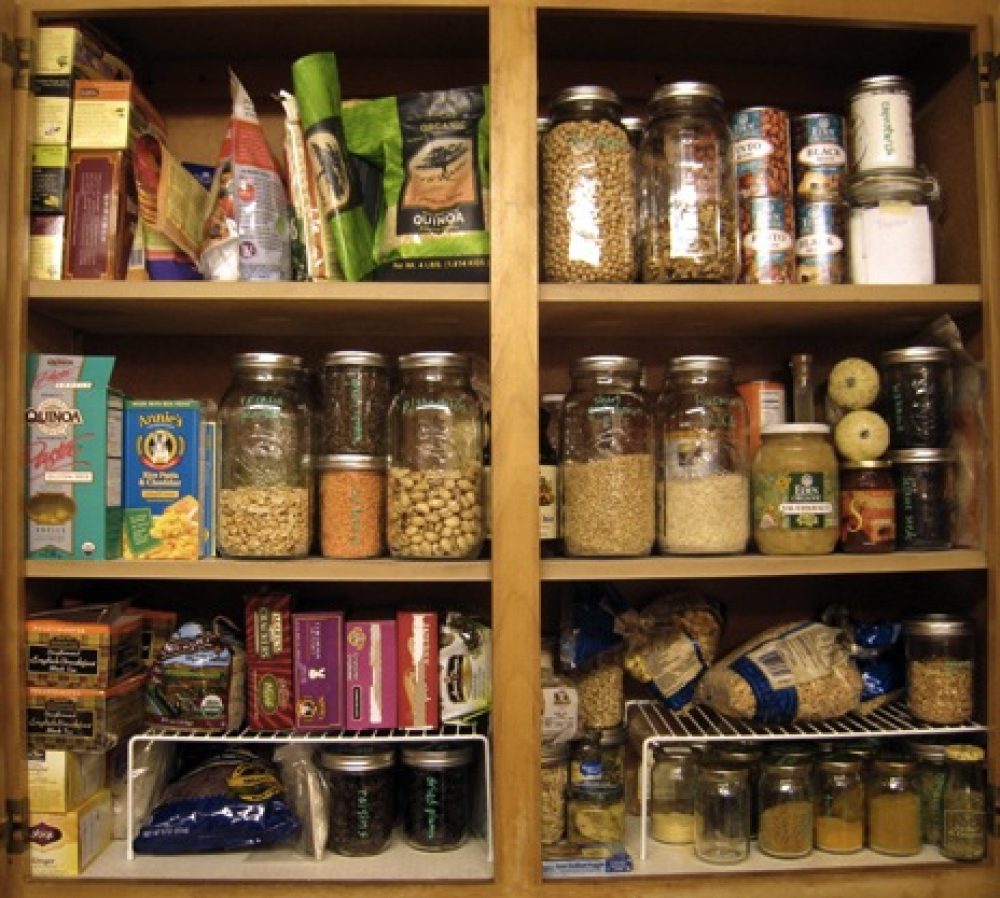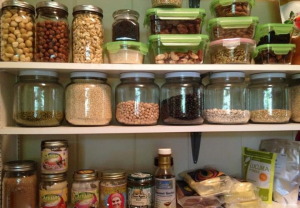
It’s Time To Rethink Your Pantry! Cut Down On Food Waste With These Simple Steps!!!
by TJ June 15, 2014 3 commentsIt’s Time To Rethink Your Pantry!
By: Tommy “Tj” Sotomayor
Een though we all love to cook with ultra-fresh, seasonal ingredients, there are times when we need to put together a meal that doesn’t entail a trip to the grocery store or farmers market. That is where a well-stocked and organized pantry comes in: As I wrote last summer, it is your key to big flavors fast.
These days, alas, most American kitchens, even fancy-schmancy ones, have no true pantry. Instead, home cooks must cram their dried, canned, and packaged foods into a kitchen cabinet or two. The upside of this development is convenience—having pantry ingredients so close at hand makes it easy to put dinner on the table—but the downside is that kitchen cabinets or cupboards are generally warmer and more humid than is optimal for long-term storage. If you’re renovating a kitchen or apartment, though, or moving into new digs, it’s worth it to figure out how to create a dedicated pantry or storeroom that is cool, dry, and dark. In the long run, it will save you money, prevent food waste, and allow you to concoct delicious meals in a snap.
Why a Pantry Should Be Cool
According to Cheryl Mendelson’s masterful Home Comforts: The Art & Science of Keeping House, canned, bottled, and packaged foods retain their quality longer and better when stored at temperatures lower than 85° F; 75° F is better, and the cooler the better—50° F is ideal, she noted. And according to the National Center for Home Food Preservation, home-canned foods “shouldn’t be stored above 95° F or near hot pipes, a range, a furnace, in an uninsulated attic, or in direct sunlight. Under these conditions, food will lose quality in a few weeks or months and may spoil.” The center’s website includes important tips on identifying and handling spoiled canned food.
Why a Pantry Should Be Dry
Humidity causes crackers, cookies, and cereals to lose their crispness. It also causes mold on breads and other baked goods; this happens especially quickly if they are free of preservatives. Baking supplies such as sugar, salt, baking soda, and baking powder won’t get moldy, but they will cake; brown sugar will turn into a solid brick. The National Center for Home Food Preservation will also tell you that dampness may corrode metal lids and break seals of canning jars, thus allowing recontamination and spoilage.
Why a Pantry Should Be Dark
I have to laugh every time I see a book or magazine feature that shows pantry goods decanted into glass jars and artfully displayed on open shelving in a sunny kitchen. That may look beautiful and efficient, but unless you go through those ingredients fairly quickly, the light will cause deterioration—in particular, of oils and dried herbs and spices. So keep your pantry dark unless you are in there rooting around for that can of whole tomatoes you know must be there somewhere. Which leads me to…
A Few Tips on Organizing Your Pantry
• Cleanliness is tops on the list. Pest prevention is the obvious reason, but crumbs and dust contain microorganisms and molds that can spread to foods, and a layer of grime on shelving and containers doesn’t inspire anyone to want to cook something delicious.
• Relatively shallow shelves (about three cans or jars deep) make it easy to avoid overbuying; you can also survey meal options and gaps in your inventory at a glance.
• Rotate your stock: When you buy new foods, tuck them behind older packages of the same thing so you use the older items first.
• To prevent infestations of insects or other pests, store rice, flour, sugar, cereal, etc., in airtight canisters or inexpensive canning jars with screw-tight lids. Maria Speck, author ofAncient Grains for Modern Meals, transfers all grains from their packages into individual canning jars before storing in her pantry. “To make it easier,” she wrote, “I keep quick-cooking grains on one side of the shelf and slow-cooking grains on the other.” She noted that storing grains in glass jars has other advantages. “It allows me to visually inspect my grains on a regular basis. And it allows me to shake my grains…. I have learned the hard way that flour moths grow in undisturbed environments.” She recommends shaking jars about once per month and checking for clumps or other signs of spoilage. For more wisdom from Speck, check out this column on soaking grains.
What Belongs in the Pantry
• Unopened canned, bottled, and aseptic-packaged foods: Condiments, pickles, salsas, jams, maple syrup, peanut or almond butter, unsweetened coconut milk, soups, and broths. Unless the label states otherwise, always refrigerate after opening; if the food is in a can (sardines or tomatoes, for instance), transfer the leftovers to a storage container first. (I prefer glass.)
• Pasta and dried noodles
• Rice
• Dried cereals
• Whole grains: Many people, especially if they live in a hot, humid climate, like to store whole grains in the refrigerator or freezer to preserve their freshness. I do that in the summer, when my apartment kitchen is stifling, but for the rest of the year, I find I use them more if I see them every time I open my pantry cupboard door.
• Dried beans and other legumes
• Baking basics: Pure vanilla extract, unsweetened cocoa powder, baking chocolate and/or chocolate chips, baking powder, baking soda, sugar, all-purpose flour. Unless you use them frequently, keep perishable whole-grain and nut flours in the freezer for optimum freshness.
• Tea and coffee beans: Store in airtight glass or ceramic containers. For coffee, only buy what you will use within a couple of weeks—according to the National Coffee Association, the beans begin to lose their freshness almost immediately after roasting, so purchase in smaller quantities.
• Dried spices and herbs: Ground spices lose their potency quickly, so I like to buy mine whole (except cayenne, paprika, turmeric, and Colman’s mustard powder) and grind them as needed in an electric coffee grinder I keep just for spices. Keep seeds with a high oil content (poppy, mustard, sesame) in the freezer, because they turn rancid quickly. As for the rule of thumb that says you should throw out dried herbs and spices after six months or a year, I say, not so fast. It really depends on what herbs and spices you’re talking about (herbs are more fragile than spices, and saffron threads, for instance, keep their flavor for up to three years if stored properly), if they are ground or whole, how old they are when you buy them, and how you store them. If you keep them in clear bottles on a spice rack next to the stove, for instance, or where sunlight hits them, they won’t last long. But if you buy good-quality herbs and spices from a place with high turnover (so that their stock is fresh), and keep them cool, dry, and in the dark, they’ll last longer. And before using ground dried herbs and spices, take an experimental sniff. If they smell dusty or musty, toss them into the trash or the compost, not the soup pot.
• Oils and vinegars: Keep oils such as olive, vegetable, or coconut—whatever ones you use often—in the pantry. It’s a good idea to store nut oils (such as walnut or hazelnut) and seed oils (toasted sesame, flax), which are very perishable, in the fridge. According to theVinegar Institute, “because of its acid nature, vinegar is self-preserving and does not need refrigeration. White distilled vinegar will remain virtually unchanged over an extended period of time. And, while some changes can be observed in other types of vinegars, such as color changes or the development of a haze or sediment, this is only an aesthetic change. The product can still be used and enjoyed with confidence.”







3 Comments so far
Jump into a conversationLana, my wife is a HEAVY user of these methods of storage. She does a lot of what you have listed here. I am allowed to restock, but I cannot change the order of her shelves lol… thanks for the tips! We waste very little here thanks to methods like these.
Great info Chef. By my calculations about 65% of TJ’s audience should be absorbing these post…where they at?
I’ve been sued twice for child support. The combined number of times those women cooked for me before telling me they were pregnant, multiplied by 500, equals zero.
Great post! Many people (including myself) aren’t aware of all these tips. This is definitely great information everyone can use. Thank you so much!
Only registered users can comment.